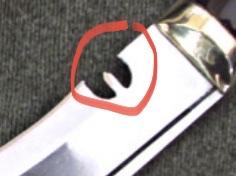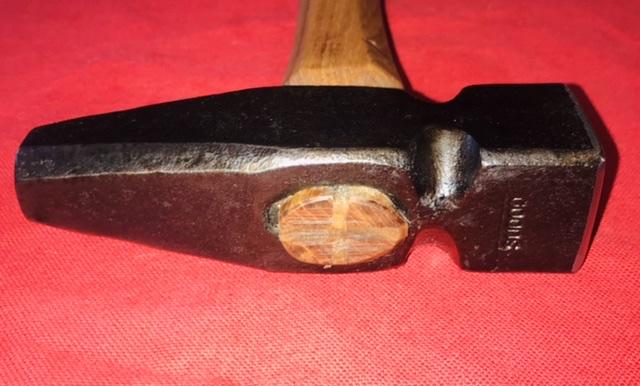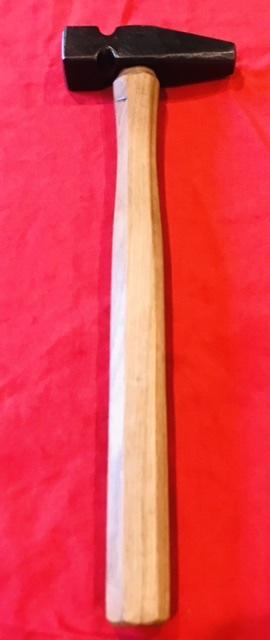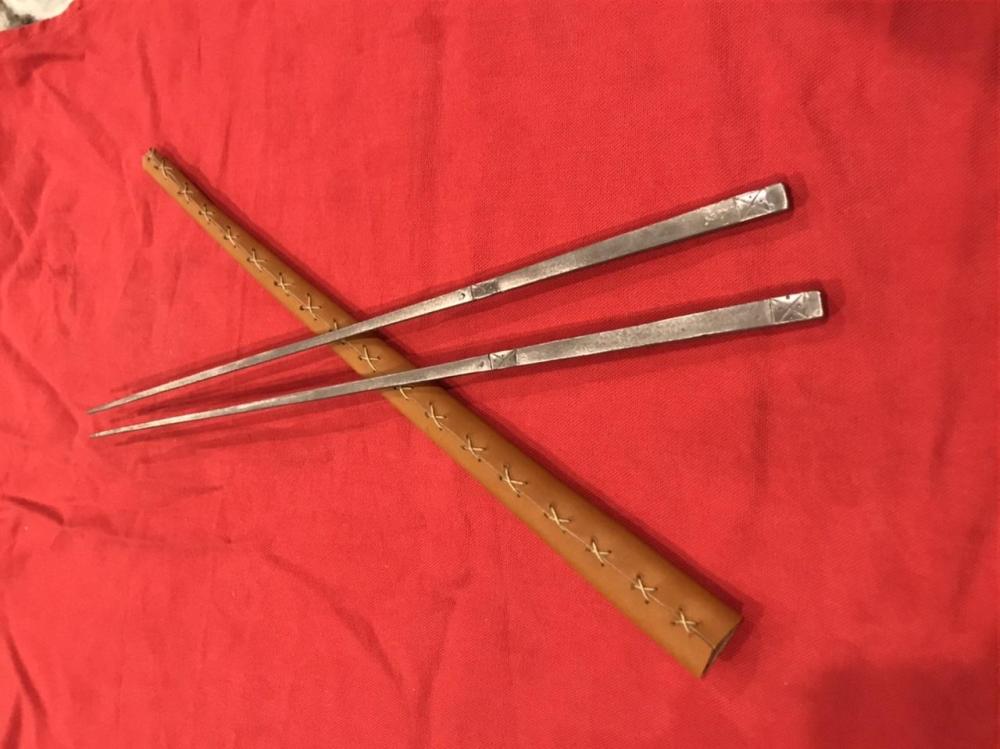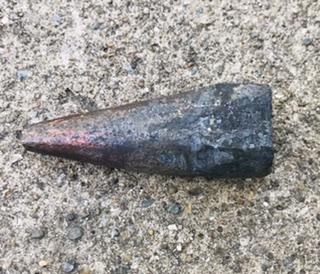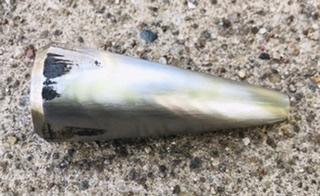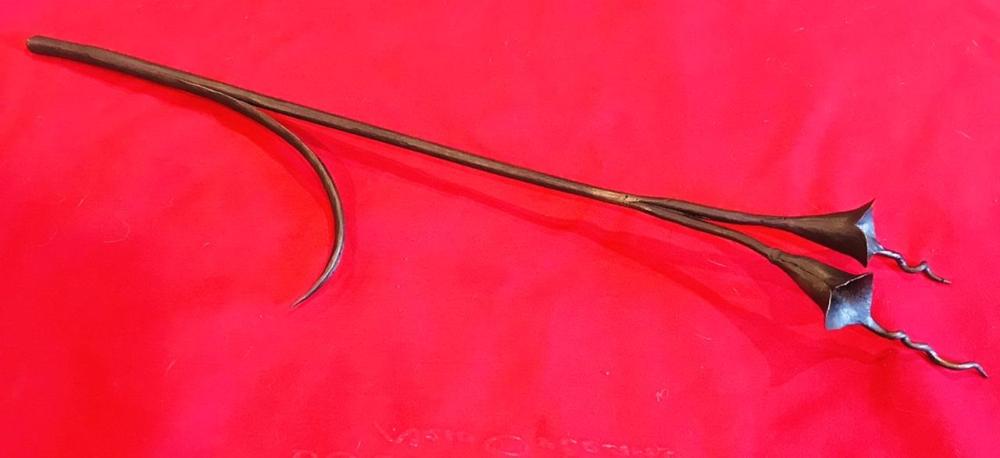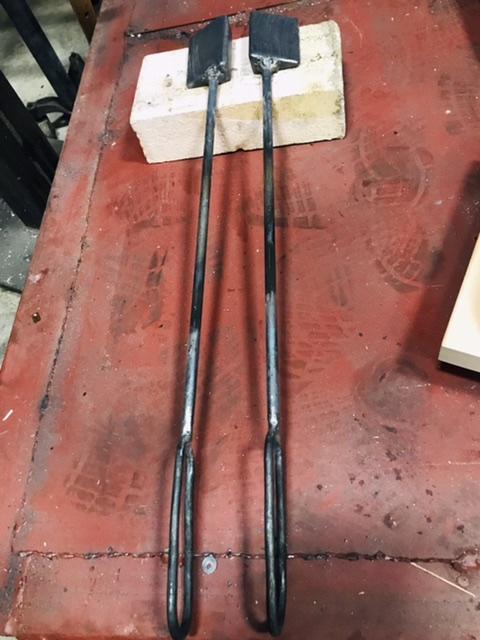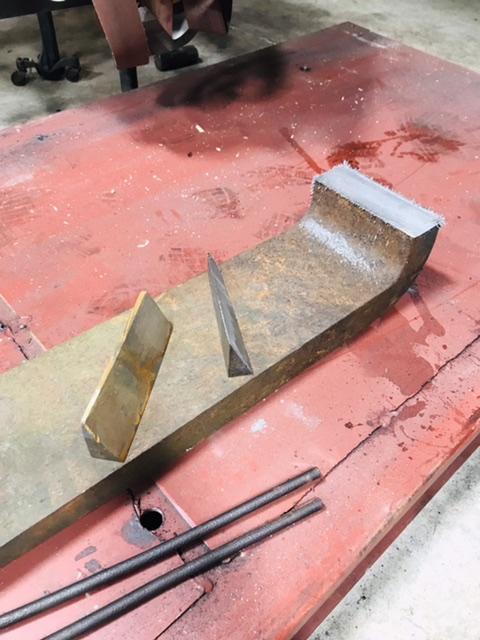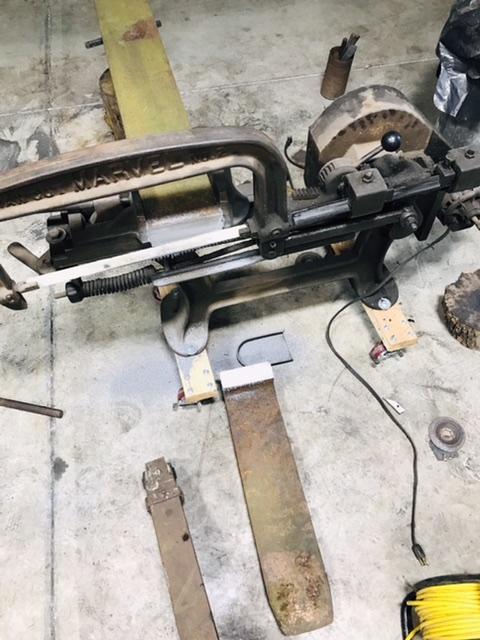-
Posts
1,159 -
Joined
-
Last visited
Content Type
Profiles
Forums
Articles
Gallery
Downloads
Events
Everything posted by Goods
-
I would definitely defer to Frosty’s knowledge here on forge design/performance, but I’d be concerned over the hinge setup in general use. If you have to open the front door for large forgings, I’m pretty sure you’ll end up fumbling around fighting to keep the door open while your pulling you piece in and out. I’d change it to a double hinge on a vertical axis or let it open down rather than open up. Keep it fun, David
-

What did you do in the shop today?
Goods replied to Mark Ling's topic in Blacksmithing, General Discussion
WR, looks really good for a first! I’m assuming you’re going to smooth the bevels out some more. That’s just a little constructive criticism, overall I really like the style. How’s it feel in the hand? Keep it Fun, David -

What's your latest blade look like? Post em and let us see.
Goods replied to HondoWalker's topic in Knife Making
You could put a slitting point on the knife for slitting the sheathing on Rolex wire, like you occasionally see on kukurris: The shape would need to be developed to cut the sheathing with out nicking the insulation on the conductors… Keep it fun, David -

What did you do in the shop today?
Goods replied to Mark Ling's topic in Blacksmithing, General Discussion
Finished up a set hammer which is an over due door prize from our hammer-in last month. (I felt really bad about forgetting that I was supposed to to be bringing one!) Keep it fun, David -
If you don’t want to burn you touch mark in, hit me t with a light tap. Then you can paint over it and then sand the paint off the surface. Black paint would look good, but you could pick any color… Keep it fun, David
-
For filing and LIGHT work that would be ok. But, it is not a post vise. It’s a vise on a stand and is most likely brittle cast iron. Blacksmith’s post vises are wrought iron or steel, the fixed jaw’s leg is one piece all the way to the ground, with forge welded or riveted cheeks to support the moving jaw. They are made to take a beating. (My medium sized post vise has 4-1/2” jaws and is about 90lbs without a stand. I’ve upset 1” square in the vise with a 10lb sledgehammer. That is what they’re made to withstand.) Too bad your not in my area, I’d sell you one of mine for that price… Keep it fun, David
-
I bought some grade 2 awhile back for a project and while at temperature if forged very easily, but got hard quickly as it lost color. It also really didn’t want to be filled at all! I had to opt for a heavy wire wheel finish and only sanded/polished decorative sections. Now that I have a belt grinder I would probably use that for finish such a part, but Ti sparks are really bright! Keep it fun, David
-

What did you do in the shop today?
Goods replied to Mark Ling's topic in Blacksmithing, General Discussion
I like both the shepherds hook and the key rack. Both are well done! We had the IBA state meeting to day in Venon, IN (but only local chapter members attended) and I made a couple items: Scribe from 3/8” diameter coil spring and 3/8”x3/4” mild bar collar welded on for the diamond. Ruffed out a power hammer punch from Atlantic 33. Cleaned up the punch back at my shop. Keep it fun, David -

Tempering a Scythe with Pre-Industrial Technology
Goods replied to Chloe's topic in Heat Treating Knives, Blades etc
Traditionally, weren’t scythed mild steel with the edge peened to sharp work,hardening them in the process? I imagine 1070 would work harden pretty quickly. David -
Looks to me like it time to enjoy the fruits of your past shop time for a while first. Enjoy, David
-
The wrenches look pretty good as is and being chrome plated would make a very significant health hazard in the forge. David
-

What did you do in the shop today?
Goods replied to Mark Ling's topic in Blacksmithing, General Discussion
Made a calla lily today at our hammer in. Yes, I took some artistic license on this, and still working on improving these. Drop tong weld failed, but the flux core helped with that. (Not happy about that at all.) Overall, happy with the piece though. Made from 4” of 1/2” round and 5/16” square out of the bin. I also forged out some test pieces of the forklift tine I have. Both water and oil quench showed really tough results. (Sorry, didn’t take pictures of the break and left them at the shop.) Keep it fun, David -

What did you do in the shop today?
Goods replied to Mark Ling's topic in Blacksmithing, General Discussion
I got my side sets almost finished up. now normalizing: Made from a forklift tine: The little wonky piece is going to be my heat treat test material… (Hopefully it’s not air hardening?) I also heated up the face of a 6-1/2” diameter press rod that was induction hardened on the face. Took for ever to get that hot. It’s still sitting in/on vermiculite to slow. Plan it to cut slabs along the sides for drawing saddles(?) to bolt onto the power hammer dies and a large flatter. We’ll see if I can keep the cuts straight. Keep it fun David -
It’s my understanding that Elkhorn is closing down. Once the coal they have on hand is gone so are they, might already be closed. Give them a call, I could be wrong. unhappily, David
-

Fixing a chipped anvil.
Goods replied to QbBlacksmith's topic in Repairing and Modification to Anvils
Mine was cast in Ohio, and it looks like the previous owner welded up fairly minor chipping with regular mig wire… He must have done some pre/post heating. I haven’t had and cracking, just strange crumbling/flaking of the welds, which I believe is from work hardening of the filler material. -

Fixing a chipped anvil.
Goods replied to QbBlacksmith's topic in Repairing and Modification to Anvils
Well, it’s my 150lb Colombian that had the edges welded up… -

Fixing a chipped anvil.
Goods replied to QbBlacksmith's topic in Repairing and Modification to Anvils
It looks like the previous owner may have already tried to weld up the edge. Damage may have already been done. The edges were “repaired” by the previous owner on one of my anvils, and they are work hardening over time and crumbling bit by bit. I take a good file across the bad spot on occasion to clean them up. I’m lucky, I haven’t seen any HAZ cracking yet! You may try just rounding the chips out a little. The anvils at our groups shop have really rounded edges, but we can still get some really nice pieces done on them. It just takes a little adjustment. If you need sharper radii, make a hardie block with different radii on the four corners. Over time if another one doesn’t show up (once you have one and aren’t looking, they seem to come out of the woodwork), then look into restoring it. Just make sure it’s done right, you don’t want it getting worse! Keep it fun, David -
MJ, are you left handed or right handed? Both work great! Pick what feels right to you. David
-
Freshman, what’s your skill level? My first flatter, that I still use now, was a cheap flea market 2~3lb hammer that I upset one off the faces on. I kept the heat focused on that face and upset it with my son as a striker. Needed to forge the face squarish every other heat. It deformed the eye, but I made a custom handle to fit close enough. It’s a top tool, so a loose fit is not a problem. (That way it can follow a tapper without sending much shock back through the handle.) I’m planning to make a better looking flatter at some point, but there always seems to be something else to work on… Stop by, maybe we could hang out and make one on the power hammer. (Maybe you should put you location in your profile. Invitation is serious though!) Don’t get to hung up on perfection, sometimes it just has to work. (Of course that’s usually me…) Keep it fun, David
-
At work I would be afraid to calculate how many tons of steel we process a day. (We are a large automotive supplier, lots metal stamping, roll forming, machining, welding…). We pay a pretty good price, but from the prices we pay the cost of steel has gone up at least 10 times over inflation. Really interesting! David
-
I’ve been “processing” my folk truck tine into useable pieces. The first tools to be side sets for the power hammer, but I didn’t have the material supported properly on the first cut. So, now I have a wonk wedge to test harden and ground the second cut to a “proper” 1-2-3 trial cross section. (6” wide, so one left hand and one right hand with welded handles.) While doing the heavy grinding I noticed the sparks had basically no bursts, pretty similar to mild steel. I was thinking this would be 1040 to 4140 material, but it doesn’t look like it is. The person that gifted the tine to me said it’s probably 4130. Anyone have any experience with this 4130 spark test? Maybe super quench for this? Sounds like I’ll be doing some hardness testing with the wonky wedge… (Side set doesn’t really need to be hard anyway, but was hoping to harden and temper it back a bunch for toughness.) David
-

Oil Quench --- What Type to Use?
Goods replied to kayakersteve's topic in Heat Treating Knives, Blades etc
Yanni, if this testing is being done on the same sample, I’d go: Air, Oil, and then water. If it will harden in oil, it will harden in water and possibly be destroyed. (The argument can be made that testing the same sample over and over with change the result, but if you going this route, you’re only looking at basic “it got hard!”) Keep it fun, David edit: not a guru, just my two cents… -

What did you do in the shop today?
Goods replied to Mark Ling's topic in Blacksmithing, General Discussion
Not been in the shop much recently. Today, I started a little cleaning, cut the steel shipping crate frame from my power hammer apart. (It was strange, basic angle iron construction, but sparked like medium carbon steel.) Also re-handled one of my hammers, and made the first cut on a forklift tine to break that into useable stock. Only took the old marvel 26 minutes to cut through it: It was really strange spending so much time out there and never lighting the forge. Keep it fun, David -
Natkova, I’m a bit of an introvert myself, but here there is a pretty strong community (Indiana Blacksmith Association). We meet every month officially, but many of the members talk or hang out much more regularly. I’m not sure what the blacksmithing culture around you is like, but don’t be wary of letting other know what you are up to. It may generate more interest and get something started for your area. (What’s more fun than playing with fire and beating on things? ) Keep it fun, David

